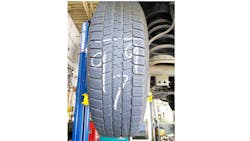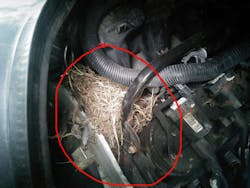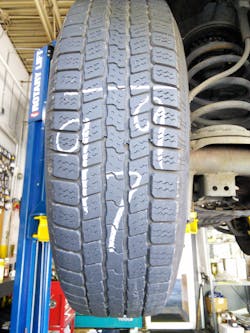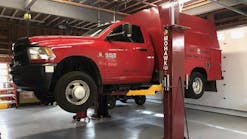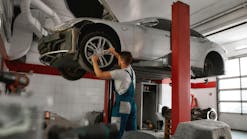Digital inspections and wear history can keep needed work on top of customers' minds
When I started in the field in the early 1980s, vehicles needed to be serviced basically every three months or 3,000 miles. Servicing usually included changing the oil and checking and topping off the battery and coolant, in addition to inspecting other items. These regular visits to the shop kept the vehicle care at the forefront of the driver’s consciousness. They also resulted in vehicle wear items being monitored and regularly reported on a few times each year.
With today's vehicles using sealed batteries and cooling systems, fuel injection, and other advances, they may be legitimately seen only once a year, though recent statistics also show that Americans drive an average of 14,000 miles a year. Based on this and some standard OEM recommendations, this may possibly bring a vehicle into a shop twice a year to be checked.
These extended intervals present both customers and shops with a number of challenges. For customers, out of sight means out of mind. Trying to remember to get their oil changed maybe once or twice a year is not something that they're constantly thinking about, let alone are they thinking about other items such as brakes and tires that are wearing all along at the same time. So, what happens is that drivers get a rude reminder that service is due in the form of a reminder from a maintenance light going on or hearing the grinding of the brakes every time they come to a stop.
For shops, these extended intervals make it more important to have a notification system in place that automatically reminds customers, via text message, that they have a service coming due soon. And with the time and mileage that passes between each service, a shop has to be more diligent in performing the required work and inspecting the vehicle. Documenting the vehicle's condition during inspection is now a must to help prevent possible liability in the future.
These longer intervals in vehicles are the result of technology: fuel injection that precisely meters the fuel, synthetic oils that work better and last longer, and engines that are built to the “nth” degree. Some of the same technology can also change your service process to easily meet all the needs listed previously.
Using digital inspections to document the vehicle's condition every time it's in will help solve many of the concerns listed above. Unlike paper inspections, which are often a lot of information scribbled on a piece of paper, digital inspections have the vehicle information clearly entered. The step of retyping everything that's on the paper inspection sheet into the management system no longer applies, either. Additionally, unlike paper inspections that seem to disappear right after each visit, digital inspections are always available with just a few clicks.
Digital inspections take documentation a step further with the use of pictures and videos that show exactly what the condition of an item was when it was inspected. Many digital inspections also allow a technician to mark up pictures, further defining exactly what they found. Videos can be used to document movement on items that should otherwise be tight, such as ball joints. Sound in the videos can also be used to document unusual noises like a belt squeak found during inspection.
When received, the customer just taps on a link on his or her digital device, and the inspection opens. The inspection is made up of a series of points, and each point may represent a vehicle system or a specific part of the vehicle.
Points provide four critical pieces of information about the item that was checked. First, there is a note. This describes the condition that was found, whether the item is good or needs to be addressed. Next, there's a recommendation, which is where the technician tells the driver what is needed to address the found issue. On many digital inspections, both of these items may have canned descriptions that the tech just taps on, selects, and enters. In many cases, the technician can also use speech-to-text to enter what he or she found.
The color swatch on each point indicates the urgency of what was found:
Green means good
Yellow means caution, and the issue should be addressed soon since it is not safety-related.
Red indicates the item has completely failed or is safety-related and must be addressed immediately.
The last part of the point is the picture or video illustrates what has been described by the three other parts of the point. Pictures should be taken so customers understand what is being indicated. Being able to mark up pictures makes it even easier for them to see the “why”.
With all this information, the inspections can be used to build what is called a “wear history.” A wear history will show how an item is wearing over a number of different inspections. Customers can watch through the subsequent inspections how the brakes and tires are wearing over time. This can allow them to financially and mentally prepare for when it's time to replace the items.
For example, tires are measured across the tread with the reading written in chalk right on that tread. If the reading was 8/32 or 8mm, the number 8 would be written on the tread. Each inspection after that will show the number going down. Basically, the photo counts down till it’s time for “retirement”.
For the wear history to be effective, it requires the customer to return for regular service and inspections. This benefits the shop by getting that customer to return. Returning customers purchase more. And with the wear history in place, customers are more prepared for upcoming work that is due, so they will be more likely to get it done.
Any recommendations that are the result of the current inspection can automatically be put on the current invoice as reminders for the customer to know when he or she will need to get them done in the future. Additionally, some inspection software can even set the next appointment and schedule an automatic reminder text message to get those customers back in when it's time.
Over time, if a customer were to ask any questions about some service that's due, the shop will be able to pull up all the previous inspections and show the customer exactly how the wear occurred. Because of this transparency and flexibility, digital inspections build customer trust.
Using digital inspections to build a wear history of needed work can always be kept in front of the customer’s mind. Also, using digital technology can automatically remind those busy customers when it's time to come back to your shop and buy more. At the same time, building documentation keeps your shop safe and secure by limiting its liability.
